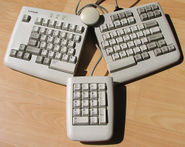IBM Adjustable Keyboard
 | |
| Part number | 13H6689 (IBM), 1428401 (Lexmark) |
|---|---|
| Branding | IBM, Options by IBM, Lexmark |
| Manufacturer | Lexmark |
| Layouts | 89-key Split Keyboard ANSI Layout (with optional, separate 17-key numeric keypad) |
| Keyswitches | Buckling spring over membrane |
| Interface | PS/2 (AT adapter included) |
| Weight | 1.55kg |
| Years of production | 1994–1995 |
| Price | $179 (standard) $199 (with numeric keypad, later included as standard) |
The IBM Adjustable Keyboard, also marketed by Lexmark as the Lexmark Select-Ease Keyboard, and most commonly known by IBM and Lexmark's manufacturing designation Model M15, was a split-layout buckling spring keyboard manufactured by Lexmark from 1994 to 1995. It is widely considered by both users and experts in ergonomics to be one of the finest ergonomic keyboard designs ever produced. Due to its popularity and short production life, it commands a hefty premium on the second hand market.
History
The M15 originated at Lexmark in 1993. Regular production appears to have began in 1994. Lexmark manufactured the M15 for IBM, who marketed it as the IBM Adjustable Keyboard through their Easy Options accessory brand/service. The IBM Adjustable Keyboards have been spotted with two different logo styles - "Options by IBM" (more common) and a standard blue IBM logo (less common). Lexmark themselves also marketed the keyboard directly to the public as the Lexmark Select-Ease.
The M15 was the subject of a patent dispute from Mark Goldstein, founder of the Goldtouch company, over the design of the adjustable ball joint, and was settled by a subsequent licensing agreement. In late 1995, Lexmark sold off certain designs and tooling relating to buckling spring keyboards, including the tooling necessary to make the M15, to Maxiswitch. Maxiswitch never produced any M15 keyboards themselves, and attempts to reacquire the tooling by interested parties have proved unsuccessful.
Design and features
The M15 is based upon the chassis of the Model M2 keyboard, and uses the same lower profile style of keycaps that are incompatible with those on a standard Model M keyboard. It also uses plastic stabilizers on the large keys. Care should be taken with these as they can break easily. As with the M2, there is no metal backplate under the membrane, accounting for its flat profile and relatively light weight.
The keyboard is split into two separate halves, that can either be detached from each other, or joined together on a ball joint that allows adjustment of the angle and height at which the two halves faced away from each other. The space bar was split across the two halves. The keyboard came with a feature named "Erase-Eaze", which allowed the user to turn one of the two space bar halves into an additional backspace. There was a switch at the back of the keyboard that enabled this functionality, and the user would cycle between the left or right half acting as Backspace by pressing Left Control, Left Shift and Left Space.
The keyboard also offered a standard keyboard height adjustment feet, although there were three levels of adjustment - a short foot, a longer foot, and the possibility to further raise the slope by inserting a screw into the longer foot. An optional numeric keypad - part number 1403599, attached to a special port on the keyboard.
Gallery
- M15 Keyboards
External links
- Business Wire — LEXMARK'S ADJUSTABLE SELECT-EASE KEYBOARD NOW FEATURES DETACHABLE 17-KEY NUMERIC PAD
- Business Wire — Maxi Switch Inc. to acquire two keyboard products and Buckling Spring technology; Maxi Switch to produce Select-Ease and Buckling Spring keyboard
- Webwit.nl — Scan of the IBM Adjustable Keyboard manual



